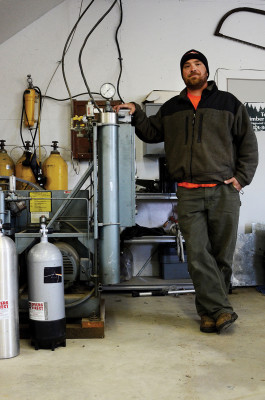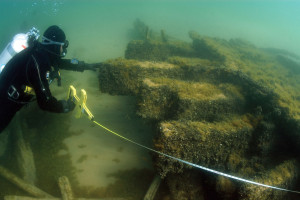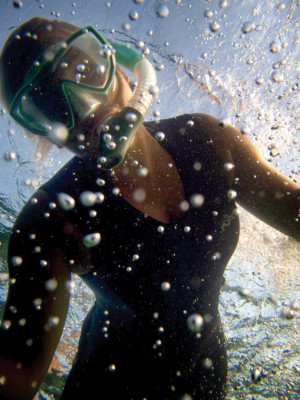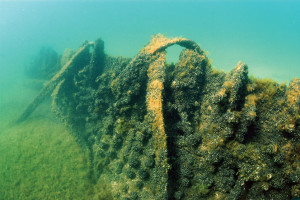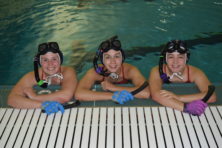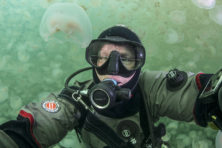Where Underwater Treasures Lie
- Share
- Tweet
- Pin
- Share
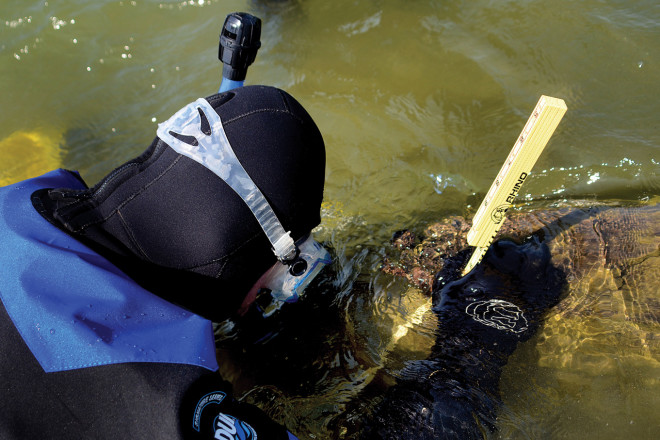
Mention archeology in Door County and people will likely envision dusty excavations in an Egyptian pyramid. But there’s plenty of action much closer to home – right offshore, in fact, beneath the waters that surround us.
In the 19th and early 20th centuries, the Great Lakes were teeming with sail- and steam-powered ships, and hundreds of them went down near Door County. Between 1851 and 1901, 42 ships sank and many more were stranded along the 18 miles of coastline from North Bay to Jacksonport. Baileys Harbor’s rocky outer reef was the site of the sinking or stranding of 20 of them.
Over the years, much of the wreckage has drifted from its original location and, in many cases, sunk deep into Lake Michigan’s sandy bottom, but the cold, fresh water is ideal for preserving artifacts. In many cases, the wrecks were in shallow water so close to shore that the curious could examine them from rowboats and take away as souvenirs anything that wasn’t, quite literally, nailed down.
Prior to the passage of the Abandoned Shipwreck Act of 1987, it was not illegal to remove artifacts from wreckage. For example, in the early 1960s, Bob Brandriff of Baileys Harbor owned the Dive Shack next door to Husby’s in Sister Bay. An avid diver, he brought up several major finds, including a large anchor believed to be from the schooner Peoria, that sank in 1901 in Baileys Harbor. A crowd of several hundred people, some of them claiming the anchor should remain in Baileys Harbor, was dispersed by Sheriff Hollis Bridenhagen. Brandriff notes that, at that time, when a qualified salvager put a buoy on a ship or object, it was a legal claim, like a mining claim. A fluke of the anchor had been spotted a few days earlier by teenage Chuck Brann, who was swimming in the harbor about 200 yards from Nelson’s Hardware Store.
The anchor ended up at the Sturgeon Bay Yacht Club. A 12-foot windlass, recovered the same summer in 50 feet of water near the Sister Islands, was donated to the Manitowoc Maritime Museum. Now that Sturgeon Bay has a maritime museum, Brandriff wishes he could bring it back.
Since 1987, Wisconsin’s historic shipwrecks are held in trust by the state. The Wisconsin Historical Society and the University of Wisconsin Sea Grant Institute are dedicated to preserving historic shipwrecks and facilitating responsible diver access. Removing or defacing artifacts is punishable by fines up to $5,000. The motto is “Take nothing but pictures. Leave nothing but bubbles.”
Jake Gransee of Sister Bay grew up working on fishing charters in Baileys Harbor. Captain William Shastell, the owner of On the Rocks Dive Shop, drew a map to help him and his buddies find and snorkel some of the shallow-water wrecks when they were about 12. Jake was always fascinated with them, although he didn’t know the names of the ships or their history. He and his friend, Todd Haleen, earned their SCUBA certification on a trip to Florida in 1988, when they were 14 and 15, respectively. Now Gransee is the owner of Dark Side scuba diving business, specializing in dives on local shipwrecks. New customers make up about half of his business, while the rest come back year after year.
Since the 1980s and ‘90s, Gransee says, diving has become more affordable. In the early days, most people – like those who first experienced salt water diving on honeymoons in Mexico or the Bahamas – were just interested in recreational diving. As equipment has improved, divers have become more technically oriented and more interested in looking at shipwrecks, with the Baileys Harbor area a prime site.
“The Frank O’Connor is a great first dive,” Gransee says. “At 65 feet, it’s not too deep and not too far from shore.” It’s also one of the best-preserved wrecks, even though it burned to the waterline. The propulsion gear – the 20-foot steam engine, 12-foot propeller and twin Scotch boilers – is intact and upright, and the bow section holds two anchors, chain and the windlass. The ship is pretty flat through the mid section due to the fire that caused it to sink and subsequent salvage efforts.
The Windsor, a schooner that sank near Cana Island in the fall of 1893, was discovered 50 to 60 years ago but has since been lost again. Gransee says it will make an excellent second dive for his customers when it is relocated.
Exciting discoveries are still possible. The Australasia, that sank close to Whitefish Dunes in 1896, was featured in a Peninsula Pulse story this past summer. It was found by two jet skiers. Many artifacts are still on the site, and divers have set them where they can be easily seen by others.
And then there’s the elusive F. J. King, a 140-foot schooner that sprang a leak and sank in a storm on September 15, 1886, three miles off Rowleys Bay. She went down in 25 fathoms of water (150 feet) and hasn’t been seen since. The group that rediscovered the Frank O’Connor in 1990 was searching for the King. And with good reason: the Green Bay Scuba Club has a standing $1,000 reward for the person who finally locates the wreckage of the ship.
A group searching for a fortune in gold, rumored to have sunk near Poverty Island, announced last summer that they had found the Griffin, the boat built by LaSalle that sank in 1679, reportedly off the tip of the Door Peninsula. Lots of people, through the years, have claimed to have found the ship. “If this group has really done it,” Gransee says, “it will probably be made public in 2013.”
Thanks to a new business in Baileys Harbor in 2012, you don’t have to get wet to view some of the shallow-water wrecks. Like Gransee, Todd Haleen grew up here and began crewing for his dad’s charter fishing business when he was 10. And like Gransee, he turned his childhood passion into a business. Licensed at 18, he now owns Lakeshore Adventures that offers fishing expeditions, along with kayaking and snorkeling tours.
Because he’s always been fascinated with shipwrecks, Haleen hoped to purchase a large clear-bottom boat that would let people view the wrecks from a dry seat. Finding that too expensive, he bought a dozen clear-bottom kayaks last summer and offered tours from Anclam Beach, Cana Island and Cave Point. They proved so popular that additional kayaks were ordered before the summer was over. Haleen expects the 2013 season to be even busier.
Lakeshore Adventures also offers snorkeling tours around the shallow wrecks, with experienced guides and all the necessary equipment. Members of the Green Bay Scuba Club come up periodically to introduce people to scuba diving with classroom and in-water training. Haleen says it’s the first time this has been available in Door County.
Not all the investigation of the area’s underwater history is for personal entertainment though. Last summer, Russel Leitz, a retired teacher who began to dive in 1992, presented a program to the Baileys Harbor Historical Society about the work a group of divers authorized by the Wisconsin Underwater Archeology Association has done in Baileys Harbor. It began in 2003, and for the past several years, there have been two organized dives a year. They are documenting 14 wrecks, and parts from a 15th unidentified wreck may also be involved.
For three days last June, 12 divers worked wreck sites, making scale drawings underwater on two-sided slates with Mylar pages, and transferring their work each evening to a more comprehensive site plan. Nineteen pieces, the smallest 14 feet square, have been identified. “It’s like a jigsaw,” Leitz says, “and much of our work is the process of elimination – figuring out by the size of a piece or the kind of metal fasteners attached, what ship it might have come from. It’s a good thing I’ve always enjoyed puzzles, because that’s exactly what we’re working with here.”
Eventually, the results of the Baileys Harbor project will be published by Leitz. In the meantime, you can get more information about the underwater archeology of Baileys Harbor from a video of his talk on youtube.com (search for Baileys Harbor Shipwreck).
Asked why Baileys Harbor is such a favored spot for shipwreck exploration, Leitz points out that the cold fresh water and sandy lakebed are ideal for preserving the wooden ships. “Matt Carter, a professional diver/underwater archeologist from New Zealand, came here on a Rolex grant,” Leitz says. “Before this, he had only made dives in the ocean, where wood is destroyed. When he dove on the 117-foot side piece in Baileys Harbor, he said it was the most complete piece of wreckage he had ever seen.”
Leitz believes there is no other place in Wisconsin waters that has, in a relatively small area of shallow protected water, the varied structures shown in the pieces of wreckage here.


